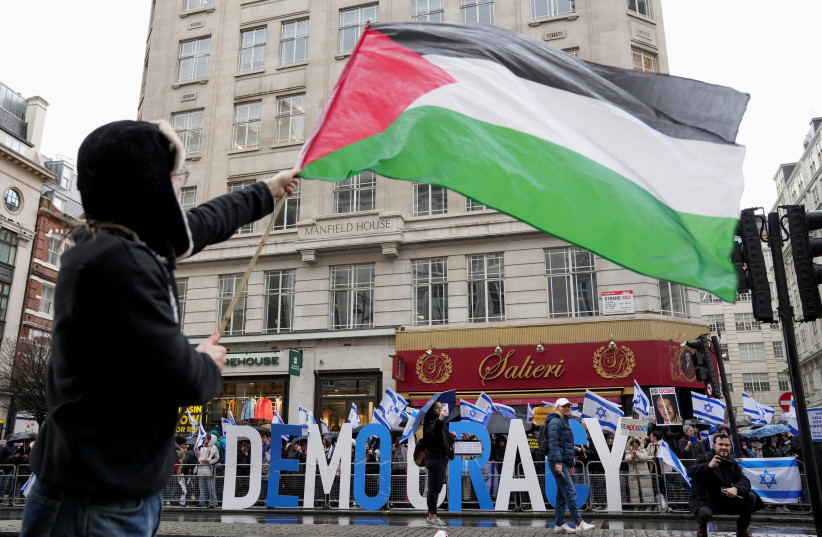What articles on Israel's 'one-state reality' get wrong - analysis

There is no evidence that Palestinians or Israelis want to live in one state, so how they would be forced to do so is unclear.
A recent article at Foreign Affairs argued that Israel and the Palestinians in the West Bank and Gaza are living under a ‘one-state reality’ and that ‘it is time to give up on the two-state solution.’
This argument has been gaining traction among some human rights groups and commentators over the past few years, though the overall theory advocating for one state does go back many decades, to the last century.
What is the premise behind Israel's 'one-state reality'?
The premise behind it is that Israeli rule has gone on for so long that the two-state solution seems too far-fetched; “one state” is what exists now. But the argument is predicated on a basic flaw thematic of all the proposals: Those advocating “one state” claim that Israel continues to occupy the Gaza Strip to portray Israel as controlling millions of Palestinians who are denied rights in Israel – this completely ignores the fact that Gaza is run by Hamas and that there is little to no evidence that Palestinians, under Palestinian Authority or Hamas, want to be integrated into Israel.
The bait and switch of the “one state” story are to force Israel to re-invade Gaza, control it and extend Israeli rule back into Palestinian cities, despite decades in which Palestinians governed cities in Gaza and the West Bank themselves. It’s unclear why anyone thinks this would work, considering that Israel can’t even fully control parts of Jerusalem when it comes to violence. Is there anything to the theory?
In January 2021, B’Tselem published a report claiming that a “regime of Jewish supremacy” exists “from the Jordan river to the Mediterranean sea,” calling it “apartheid.” The report said that “more than 14 million people, roughly half of them Jews and the other half Palestinians, live between the Jordan River and the Mediterranean Sea under a single rule.”
It added that “the entire area between the Mediterranean Sea and the Jordan River is organized under a single principle: advancing and cementing the supremacy of one group – Jews – over another – Palestinians.” It said that even though Israel withdrew from the Gaza Strip in 2005, Israel continues to control “nearly every aspect of life in Gaza from outside.” It also noted that “Palestinians from Gaza must go through Egyptian-controlled Rafah Crossing – provided it is open, the Egyptian authorities let them through, and they can undertake the long journey through Egyptian territory.”
Then, in February 2022, Amnesty International published its own report about “Israel apartheid against the Palestinians,” writing that “the entirety of the West Bank and Gaza Strip remains under Israeli military occupation, with Israel controlling the Palestinian population living there,” though it noted that “the Egyptian authorities also maintain tight Egyptian restrictions on the Rafah crossing between Gaza and Egypt.”
Amnesty asserted “Israel maintains its system of fragmentation and segregation through different legal regimes that ensure the denial of nationality and status to Palestinians, violate their right to family unification and return to their country and their homes, and severely restrict freedom of movement based on legal status. All are intended to control the Palestinian population and aim to preserve a Jewish Israeli majority in key areas across Israel and the OPT [Occupied Palestinian Territories].”
Human Rights Watch (HRW) published its own report in April 2021, writing that “about 6.8 million Jewish Israelis and 6.8 million Palestinians live today between the Mediterranean Sea and Jordan River, an area encompassing Israel and the Occupied Palestinian Territory (OPT), the latter made up of the West Bank, including East Jerusalem, and the Gaza Strip.” The report claims that in regards to Gaza, “the Egyptian government often imposes restrictions along its border with Gaza, which exacerbate the impact of Israel’s policies on residents of Gaza, but Egypt’s obligations differ since it is not the occupying power and can, with some key limitations.”
Does a one-state arrangement already exist?
The Foreign Affairs article builds upon these arguments, claiming that a “one-state arrangement is not a future possibility; it already exists, no matter what anyone thinks. Between the Mediterranean Sea and the Jordan River, one state controls the entry and exit of people and goods, oversees security, and has the capacity to impose its decisions, laws, and policies on millions of people without their consent.” The hammers home the claim that Israel “has control over a territory that stretches from the river to the sea.”
The term “river to the sea” has long been a part of Palestinian nationalist propaganda. The American Jewish Committee has noted that “the catch-all phrase symbolizing Palestinian control over the entire territory of Israel’s borders, from the Jordan River to the Mediterranean Sea,” adding that “‘From the River to the Sea, Palestine Will Be Free’ is a common call-to-arms for pro-Palestinian activists. It calls for the establishment of a State of Palestine from the Jordan River to the Mediterranean Sea, erasing the State of Israel and its people.”
The Foreign Affairs article joins many others portraying Israel as continuously controlling Gaza, writing that “even after it withdrew forces from Gaza in 2005, the Israeli government retained control over the territory’s entry and exit points.” The articles slamming Israel for “apartheid” all noted that Egypt controls access to the Gaza Strip; Egypt is not mentioned in the Foreign Affairs article.
A key part of the “one state” argument hinges on this depiction of Israel controlling Gaza, as well as downplaying what Hamas has done to Gaza over nearly two decades of rule. The article claims that “like parts of the West Bank, Gaza enjoys a degree of autonomy, and since the brief Palestinian civil war of 2007, the territory has been administered internally by the Islamist organization Hamas, which brooks little dissent.” The term “brooks little dissent” disregards the reality in Gaza, where Hamas stockpiled masses of long-range rockets during multiple wars against Israel.
To downplay the policies of Hamas, the article claims that “Israel’s system of structural discrimination is more severe than those of even the most illiberal states.” It is unclear how this was measured, considering the large number of illiberal states in the world – Freedom House, a DC-based political advocacy organization, says there are 57 countries in the world defined as “not free.”
The article also defines the Arab minority in Israel as “Palestinians who have Israeli citizenship and reside in pre-1967 Israel have political and civil rights but confront other limits – both legal and extrajudicial – on their rights, responsibilities, and protections.” In essence, this joins with the broader Palestinian nationalist “river to the sea” concept, only through “one state” advocacy. Palestinians in Jerusalem were described as rejecting Israeli citizenship because accepting it “would be an act of disloyalty,” disloyalty to Palestinian nationalism.
The article concludes by writing that “a better US policy would advocate for equality, citizenship, and human rights for all Jews and Palestinians living within the single state dominated by Israel... To that end, Washington should begin conditioning military and economic aid to Israel on clear and specific measures to terminate Israel’s military rule over the Palestinians.”
It is unclear how Israel can provide “equality” for everyone in Gaza, Ramallah and other areas run by the Palestinians while it is also told to end its military rule over these same areas. It is a contradiction to claim that Israel controls Gaza and must bring equality to everyone there, but not through military rule. How would Israeli civilian rule be extended to Gaza or Ramallah? According to the article, Arabs in Jerusalem don’t even accept Israeli citizenship when it is offered because they don't want to be “disloyal” to Palestinian nationalism. If Israel can’t get the people in east Jerusalem to accept more equal citizenship, how would it do this by re-invading Gaza? Israel can’t seem to control gun violence that is growing inside Israeli-controlled areas – how would it hope to control Jenin and Nablus and force those areas into “one state”?
There is no evidence that Palestinians or Israelis want to live in one state, so how they would be forced to do so is unclear. Historically, trying to shoehorn different groups into one state, like in former Yugoslavia or elsewhere, has not been successful. The “one state” proposals dismisses the actual reality that exists in Gaza, Ramallah, Jerusalem and Tel Aviv and the impossibility of one country governing all these places.
Jerusalem Post Store
`; document.getElementById("linkPremium").innerHTML = cont; var divWithLink = document.getElementById("premium-link"); if (divWithLink !== null && divWithLink !== 'undefined') { divWithLink.style.border = "solid 1px #cb0f3e"; divWithLink.style.textAlign = "center"; divWithLink.style.marginBottom = "15px"; divWithLink.style.marginTop = "15px"; divWithLink.style.width = "100%"; divWithLink.style.backgroundColor = "#122952"; divWithLink.style.color = "#ffffff"; divWithLink.style.lineHeight = "1.5"; } } (function (v, i) { });

